Hey there,
Nice to meet you! We are The Group of Analysts. Our philosophy: Market Research Re-engineered. For you we have thrown a light on the company Advellence regarding the MAM market. Just take a look on the left side, there you can see the Market Performance Wheel (MPW) – the result of our deep dive analysation. Besides that the following Legend will give you a great idea what every single point of information icludes. So just download the detailed MPW of Advellence on our website www.tgoa.de
The Legend
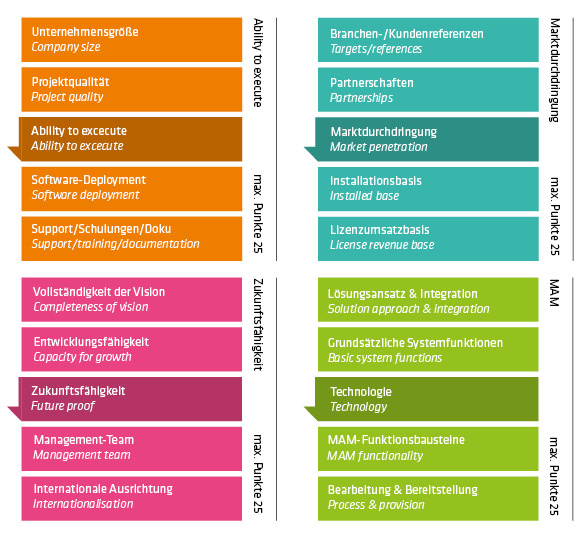
The Market Performance Wheel reflects four areas of corporate performance, which are depicted in different colours: ability to execute (orange), market penetration (turquoise), future proof (pink) and technology (green). The individual areas are further divided into four subcategories. These result in a total of 16 rated topics.
Ability to execute
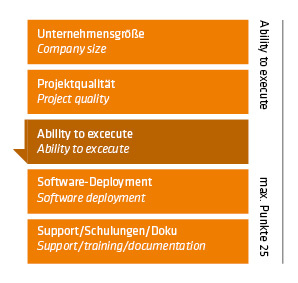
The evaluation area company size is crucial, especially for larger enterprise projects. Here the number of employees, the associated revenue for the relevant software field and the relation to the total size of the company is integrated into the analysis.
In addition to the evaluation of the software product life cycle, the topic quality of project execution mainly contains information on project implementation. Subcategories such as training and qualification of employees and partners, the methodology of project planning and the nature and composition of the project team come to bear here. The evaluation is completed by analyst interviews with customers and integration partners.
The fundamental IT structure in terms of standard software is analyzed and evaluated in the area software deployment. Here, next to the IT platforms and development environments, the section configuration management is also illuminated. Likewise, the test management, updatability, defined scaling scenarios and system monitoring are evaluated in this area.
In the evaluation area support/training/documentation the analytical result reflects the support organization with its different service level agreements using appropriate ticket systems and the customer’s access. The range of training seminars and the quality of the user documentation are also in the focus of the evaluation.
Market penetration
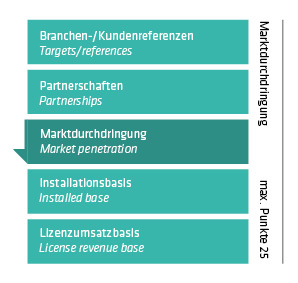
The evaluation of the targets/references reflects, on the one hand, the spectrum of possible target sectors such as industry, specialized retailers, banks, insurance companies and tourism. On the other hand, the references within target industries play an essential role. To round up this area, the actual number of completed projects, their magnitudes and evaluations of reference customer interviews are included in the analysis.
The topic partnerships values the cooperation with technology partners, associations, and research institutes worldwide, and especially the DACH network of integration partners and their realized sales volume with the relevant software. The results are also resonating qualitative information from the integrators obtained by the analyst interviews.
The number of installed systems worldwide and in the DACH market represents the installed base, which allows a quantitative assessment of the distribution of the software solution.
In comparison, the license revenue base demonstrates a qualitative assessment of the extent of the installations. This implies that a high cumulative result reflects large enterprise installations with corresponding distribution. However, a high installed base with low valuation in license revenue base does not have to be bad, but is possibly an indicator of SME-focused software solution. A low installed base can indicate a new software product, which has not yet reached its full market penetration.
Future proof
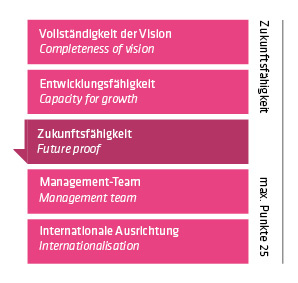
For the future proof of a solution it is critical, among other things, how clear the solution is aligned to the target audience and their needs. This is reflected in the area completeness of vision. On the one hand, it is of importance how the management team has already anticipated the topic ISCM. On the other hand, it reflects their knowledge of competing PIM software solutions and how this is reflected in the productroadmap in order to fill any gaps.
The topic capacity for growth assesses the financial opportunities that the company has to evolve and grow successfully. In this analysis, a plausibility check is performed to verify whether the planned growth rates are actually implemented.
The area management team represents how broad and how secure the management of the enterprise is or if it is, for example, still heavily dependent on the company‘s founder. Thus, a high fluctuation of executives affects the analysis result negatively. In addition to meaningful individual results, the overall competence of the leadership team − consisting of expertise regarding technology and product vision, but also for consulting, finance and partner management − is rated.
The topic internationalisation shows how strongly the company is positioning itself as a provider internationally. An analysis in this area assesses the planned expansion projects in terms of the necessary required framework, such as individual and total investment or headcount.
Technology
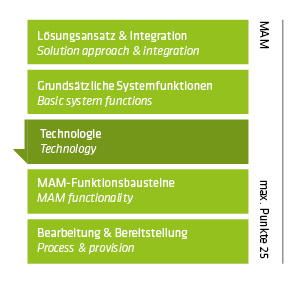
The area of assessment solution approach & integration on one hand reflects how strongly the software solution is standardised pronounced with regard to the area of Media Asset Management. On the other hand, it demonstrates the number and quality of the different interfaces of adjacent systems such as PIM, MRM, CMS, E-commerce, CRM and Print Publishing.
The basic system functions clarify assessment of the software solution with regards to rights management concerning the range of functions of workflows and support for multiple clients. In addition, the userfriendliness of the interface and the performance is analysed. The field of analysis is completed with values regarding import and export.
The field of analysis MAM-functionality counts as one of the primary building blocks in a Media Asset Management system. It encompasses all evaluations/ ratings of the fundamental data model. This is where light can be shed on all elements/modules of an MAM system from the initial data transfer to the data maintenance structure or the asset relations. Search functionality is also part of this, the functional scope of the metadata, the security templates as well as the different classification functions including heritage/ inheritance and modification options.
The category process and provision devotes itself to all modification, collaboration and output processes, originating from the basis of conversion, and reaching into special areas such as asset prossessing (singular and mass mutation), collection management with
scope for collaboration, right up to internet provision, e-commerce connections and complex integration scenarios with PIM and MRM systems (with/upon dynamic security template changes.)
Get the entire MPW with all its detailed figures on the respective groups of information on www.tgoa.de
For more information about the analysed software vendor visit www.advellence.com